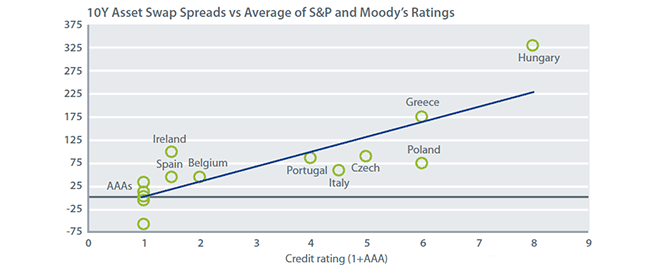Fixed Income: Tightening Seatbelts
The US Federal Reserve recently commented that it expects inflation to remain subdued for some time thus implying that it will maintain its stance of loose monetary policy for a while yet.

The Fed
The US Federal Reserve recently commented that it expects inflation to remain subdued for some time thus implying that it will maintain its stance of loose monetary policy for a while yet. For bond holders the question is: when will short term rates rise and if so, how far? At MASECO, we believe that not even Ben Bernanke knows the answers to these questions. What is for certain is that other barometers used by market participants seem to be implying inflationary expectations – strong gold and the weak dollar. When setting monetary policy will the Fed focus solely on unemployment and spare capacity and ignore inflationary expectations that appear in other asset classes? Investors will again become bemused as to which condition of Fed policy carries the most weight.
The Bureau of Labour Statistics data on productivity and unit labour costs tells a fascinating story. There is a significant correlation between inflation and unit labour costs in the US, so low labour costs in developing countries are preventing inflationary pressures at the moment in the US and it is difficult to see demand-pull inflation in the short term.
As a consequence, we expect short term interest rates to remain low well into 2010 and for Quantitative Easing to cease in the upcoming quarters in many developed countries. It is also unlikely that the Fed will spook the bond market with surprise rate rises and we expect that central banks will telegraph their intentions well in advance of taking action.
The Yield Curve
In the US, the yield gap between the 2 year Treasury and the 10 year Treasury has widened to 286bps. This is the largest gap in history as the Fed signalled it would hold short term rates steady near zero percent for most of 2010. Looking back at historical tightening cycles in 1994 and 2004 the 2/10 year gap showed signs of flattening 10 months prior to the Fed’s first rate hike. The gap historically flattened to approximately 70bps and is commonly known as a ‘bear flattener’ (where the 2-year yields rise faster than the 10 year yields). Currently this ‘bear flattening’ is not evident in the US government bond market.
Supporting the notion that short-term interest rates could stay low for an extended period is that the Taylor Rule (adjusted by Dr. Robert Barbera of ITG) is currently implying a negative Fed funds rate. The Taylor Rule stipulates how much central banks should change interest rates in response to divergence in inflation from target inflation rates and actual GDP from potential GDP.
Squeezing Credit
A year ago we were highlighting the case for credit to be included in clients’ portfolios. Credit looks cheap when rates are high and spreads are wide - this time last year the ‘spreads’ were at exceptionally wide levels. We wrote: ‘Recently high-quality credit spreads hit their widest level for 75 years (or another way of putting it – they are at their cheapest since the Great Depression… The largest bubble may currently be in US Treasuries. Yields are at their lowest level for 70 years.’ Roll forward twelve months and we look at a scenario where rates are low and spreads have narrowed and intermediate investment grade bonds have returned almost 20%. Credit therefore does not look so attractive and returns will mainly come from the more modest yields with the headwinds being increasing rates and the risk of another economic downturn. The speculative gain has been made and going forward investors should expect more modest returns. Interestingly Moody’s estimates that the trailing 12 month issuer default rate at the end of the third quarter was 13% and their future estimate is for defaults of only 4-5% in the next 12 months.
The major risks, in our opinion, for the credit markets in 2010 are with the central banks. If they withdraw liquidity too quickly the economy may fall into a double dip recession. Higher rates are obviously not good for bond investors but generally coincide with a healthier economy – which supports credit. Spreads for investment grade and high yield credit are currently above their long term averages of approximately 180bps and 700bps respectively.
When one looks at the current relative valuations between credit and cash it paints an interesting picture. If one is willing to accept the risk associated with intermediate investment grade credit then they will be compensated with an extra yield of 4.5% (on the US curve). On a historical perspective, this yield gap is attractive and investors can still be rewarded for taking this limited duration and credit risk.
Sovereign Default Lines
During the second quarter last year we highlighted the credit risk associated with certain sovereign credits. This risk continued to materialize as S&P stated that it was reassessing the ratings of Spain, Portugal and Ireland while downgrading Greece`s sovereign credit rating from ‘stable’ to ‘negative’. Dubai World also hiccupped on its debt obligations only to get partially bailed out by its wealthier cousin Abu Dhabi.
These scares have been small but what would happen if a member of the euro area could no longer finance its debt?
Greece ran persistent deficits during the good times and its new government stated that this year’s budget deficit would be more than twice previously advertised.
The European Treaty contains a ‘no bail-out’ clause that prohibits one country from assuming the debts of another. It is worth casting ones minds back to 1975 when New York City defaulted or looking at California today. Would a default on municipal debt cause a run on the dollar? New York’s bailout was punitive and resulted in tax rises and a reduction in expenditure – this enabled the President to claim that ‘New York bailed itself out’.
Sovereign credit default swaps are a good indicator of the market’s perception of sovereign credit but unlike corporations sovereigns have the ultimate debt cure of taxing a captive audience. This makes default a remote possibility but arguably puts significant pressure on currencies or economic blocs.

Morgan Stanley suggested that if Britain ends up with a hung parliament in the spring this could cause a fiscal crisis with the pound weakening further and gilt rates rising. At MASECO we would suggest that whilst the conclusion has got merit we would encourage our clients not to put much emphasis on cause and effect in advance of intertwined market movements.
Emerging Market Debt
During 2009 Emerging Market debt spreads narrowed from 700bps to 320bps over Treasuries. Generally emerging markets are sitting on current account and fiscal surpluses that look significantly better than many of their developed market cousins. It will be interesting to see how the Emerging Markets debt market develops as their economic situation becomes increasingly robust when compared to the developed world`s debt ridden debt markets. One would also expect upward pressure on currency or at least the continued pressure on currencies that are pegged to the dollar (China, Saudi Arabia, Hong Kong, etc.)
Municipals
In 2008 municipal bond prices fell substantially and were fairly inexpensive at the beginning of 2009. A year ago we wrote: ‘The municipal market is looking inexpensive as well versus the Treasury market’. Since then, municipal bonds appreciated significantly driven by reduced supply and capital flows in spite of budgetary pressures and credit downgrades. In fact municipal bonds recorded their third best year in twenty according to a Merrill Lynch index.
Multiple forces remain at work in the municipal bond market. Over the last year state finances have deteriorated and the strategy of wrapping poor credit with a AAA banner for a meagre insurance premium is the practice of days gone by. Even with these headwinds municipal bonds have rallied hard from their lows.
Moody’s recently downgraded Illinois, the second lowest rated state after California and some have argued that unemployment in California will stay in the double digits until 2012. Historically the rates of defaults for munis have been tiny as like sovereigns taxes can be raised to bolster the balance sheet. That being said, we don’t really know what would happen if a major state like California were to default on their debt and we are obviously not eager to find out.
Municipal bond prices have been supported by the development of the Build America Bond (BAB) programme. Whilst this has generally been the territory of the institutional investor it has provided the municipalities with much needed support. The issuance of the taxable BAB’s has not significantly increased the supply of tax exempt paper which could stabilize municipal bond prices. Tax revenues may also increase in 2011 if the economy improves which would help the finances of municipal bond issuers in general and further stabilize municipal bond prices.
Summary
Fixed Income investors have to be more vigilant when allocating capital in 2010. The goldilocks scenario has disappeared. Running fixed income portfolios in the wake of a global rate hiking cycle is a difficult affair. We therefore will stick to our knitting and continue to employ a disciplined fixed income strategy that does not extend itself in the credit or the interest rate environment.
^ back to top
10 Charles II Street
London, SW1Y 4AA
United Kingdom
T +44 (0) 20 7043 0455
F +44 (0) 20 7043 0456
E enquiries@MASECOfinancial.com
